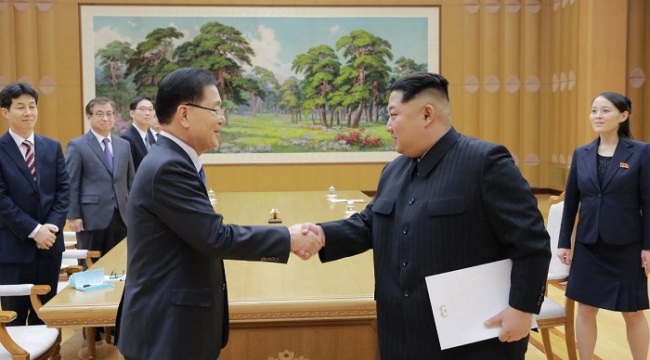South Korean President Moon Jae-in’s special envoys to the North returned Tuesday, having obtained “results” in their meeting with North Korean leader Kim Jong-un.
The special envoys, led by National Security Office chief Chung Eui-yong, visited Pyongyang on a two-day schedule, where they met with Kim and his top aides. National Intelligence Service Director Suh Hoon and Vice Minister of Unification Chun Hae-sung were also among the five-member delegation.
The envoys arrived at the Seoul Air Base south of Seoul at 5:58 p.m. Cheong Wa Dae plans to announced the results of the trip later in the day.
The envoys obtained some results from their meeting with Kim on Monday, according to a high-level South Korean official.
 |
South Korea`s National Security Office chief Chung Eui-yong (right) is received by North Korean leader Kin Jong-un in Pyongyang on Monday. Cheong Wa Dae |
“I am not sure if the term ‘agreement’ is appropriate, but there are results that are not disappointing,” a high-level Cheong Wa Dae official told reporters on Tuesday.
The official also said that the issue of denuclearization would have been brought up at the dinner, which lasted more than four hours, but declined to comment further.
The meeting with Kim Jong-un took place on the first day of the five-member South Korean delegation’s two-day visit to North Korea. The meeting was attended by Kim’s younger sister Kim Yo-jong and Kim Yong-chol, vice chairman of the North’s ruling Workers’ Party.
The meeting, followed by a welcome dinner hosted by Kim Jong-un, also saw his wife Ri Sol-ju, a move some local experts interpreted as an “extraordinary” show of the North’s willingness to engage the South.
While South Korean officials refrained from revealing too much about the visit, North Korean media claimed that a “satisfactory agreement” on an inter-Korean summit was reached.
“The supreme leader received President Moon Jae-in’s intentions on (an inter-Korean) leaders’ meeting and reached a satisfactory agreement,” the Korean Central News Agency reported Tuesday.
The news agency also said that Kim spoke “frankly about improving inter-Korean relations, and ensuring peace on the Korean Peninsula.”
Although no mention of denuclearization was made, an agreement regarding an inter-Korean summit hints that the matter was discussed.
 |
(Yonhap) |
Upon receiving Kim’s invitation to Pyongyang from his sister last month, Moon replied that the two Koreas should work together to establish conditions that would allow such a meeting.
However, it remains to be seen whether the agreements are “satisfactory” to Seoul, and more importantly, to Washington.
Although Seoul is taking the lead in North Korean issues, Cheong Wa Dae has taken on the role of the bridge between Pyongyang and Washington, with one high-level official describing Seoul’s role as “matchmaking.”
“From the point of view of the North, they (interacted with the South) on a level they desire, and if they didn’t become engaged in (the plans for) denuclearization that the US demands, (the meeting) would be considered satisfactory,” Kim Dong-yup, a professor at Kyungnam University‘s Far East Institute, said.
North Korea’s demands include an end to South Korea-US joint military drills, and to be recognized as a nuclear-armed state. The North has also repeatedly threatened the US, with the latest coming in the form of a Rodong Shinmun article that claimed Pyongyang’s nuclear weapons were a “sword of justice to forever sweep the nuclear devil from the planet,” referring to the US as the “nuclear devil.”
Seoul and Washington earlier postponed scheduled joint military exercises to until after the PyeongChang Olympics and Paralympics. The Paralympics ends March 18. Seoul’s defense minister said last month that the resumption of the drills would be announced no later than the start of April.
Significant changes to the drills, South Korean officials say, are unlikely.
“Cancelling or (another) postponement would be hard for the US to accept. (The joint drills are) conducted on a global schedule,” a South Korean military official said on condition of anonymity.
“One possibility is to conduct the drills on a low profile, such as keeping a low public profile of tactical assets deployed in the drills.”
By Choi He-suk (
cheesuk@heraldcorp.com)
Yeo Jun-suk and Jung Min-kyung contributed to this article.










![[Herald Interview] 'Trump will use tariffs as first line of defense for American manufacturing'](http://res.heraldm.com/phpwas/restmb_idxmake.php?idx=644&simg=/content/image/2024/11/26/20241126050017_0.jpg)
![[Exclusive] Hyundai Mobis eyes closer ties with BYD](http://res.heraldm.com/phpwas/restmb_idxmake.php?idx=644&simg=/content/image/2024/11/25/20241125050044_0.jpg)
